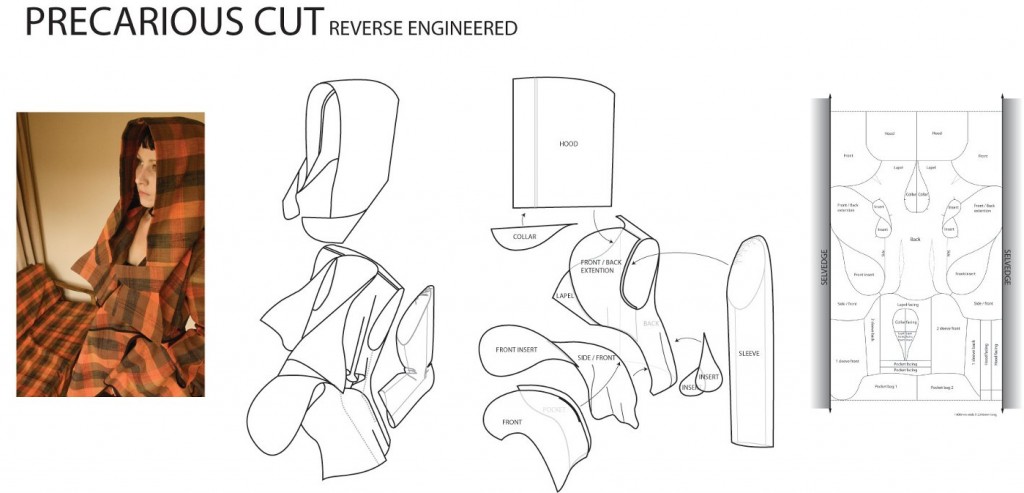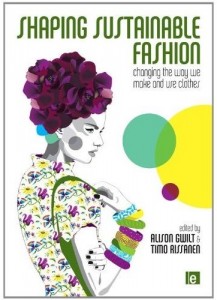Shaping Sustainable Fashion – Changing the way we make and use clothes
edited by Alison Gwilt & Timo Rissanen
ISBN: 9781849712422
Where Kate Fletcher’s Sustainable Fashion & Textiles – Design Journeys left of, Shaping Sustainable Fashion sets in and complements the picture of how to address the variety of issues in the textile supply chain.
To disappoint anyone expecting the Ultimate Solution of Wisdom: It is not. This said, the book does a very thorough job in providing clear and hands on examples and cases studies in all of the following areas along the different stages in the live of a garment or accessories item, namely:
- Sourcing: A series of 3 chapters explores the broad range of issues and complexities involved when trying to source – i.e. produce – sustainably. The chapters talk about the consequences and implications of budgets, deadlines, purchasing, shipping, selling, and supplying. Approaches to reduce carbon are discussed by example, as are alternative fabric sourcing strategies such as upcycling or use of novelty materials.
- Making: The 4 chapters, 2 case studies and 2 essays, approach an often rather neglected topic: the importance of the designer’s role. The chapters point out, quite in contrast to the common and widely accepted assumption that designers are ‘not guilty’ per se, and have little influence on the supply chain as such, how and where designers can indeed make a difference: from pattern cutting, to fabrics choice, to a garment’s robustness to wear and tear. Specifically, the importance of artisanry and craftsmenship are pointed out, and how these systemically are a more sustainable.
- Using: 4 entirely underrated key words – at least as far as the
sustainability + fashiondiscussion is concerned – sum up what this section is all about: wearing, washing, drying, and maintaining our clothes. The focus of it all is the relationship each individual has (as consumer) with the clothes. This reaches from the prices we’re paying, to why we laundry some garments more often than others, how often we wear them. And notably: How, with little effort, a lot of damage can be avoided. Highly impressive is the presentation of modern and traditional creative approaches that emerged from the simple task ofmendingclothing - Have it last: Aspects of technical and emotional approaches are introduced all of which aim at reducing – or making entirely away with – our clothes’ severely damaging impact into the environment. From upcycling projects to Cradle-to-Cradle (C2C) fabrics and DIY fashion, personalisation and hand-me-downs / vintage, the presented options give a good taste of how many options and ideas indeed can be thought of, and explored. And in all that, it is very clear that neither design nor creativity or style needs be sacrificed.

The book’s overall hands on approach – offering even examples and schemata of cutting patterns – is a positive step ahead in the discussion of sustainability in fashion. While much has been said about the theories, the issues, and what should or should not be done, suitable and exemplary practical examples and case studies are still a challenge to get by. And it is here where the book’s strength lies. In addition, the extensive reference section invites to explore further and, for designers, give it a try yourself.
The book is at times demanding to read. This is however, is not due to the language used, but rather because the arguments brought into the field, and the examples chosen, are at times so concrete already that for a non-designer it’s difficult to fathom the entirety of what is being pointed out.
On the other hand, the book changes quite rapidly between deep, highly researched and well informed content, and nearly superficial arguments and picture presentations of projects. This aspect of its presentation does indeed lack of coherence, unfortunately.
Shaping Sustainable Fashion – Changing the way we make and use clothes is a valuable in its clarity and practicality. It makes it very clear that achieving a sustainable fashion and textile industry – one where sustainability is the standard, not the exception – is a war of many, many small battles, some of which are lead within the companies designing and making the clothes, but others battles will be lead privately confined in the four walls of our home and on an individual basis.
This book is available from your nearest book store as well as online from Amazon.


